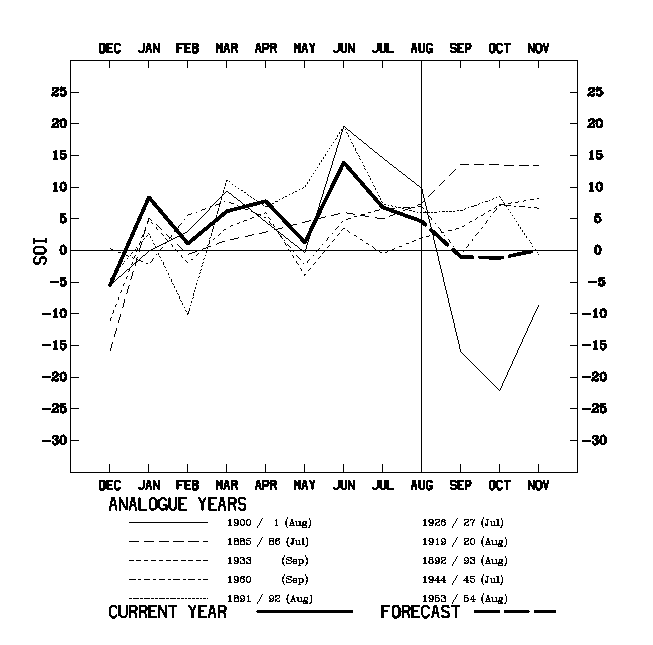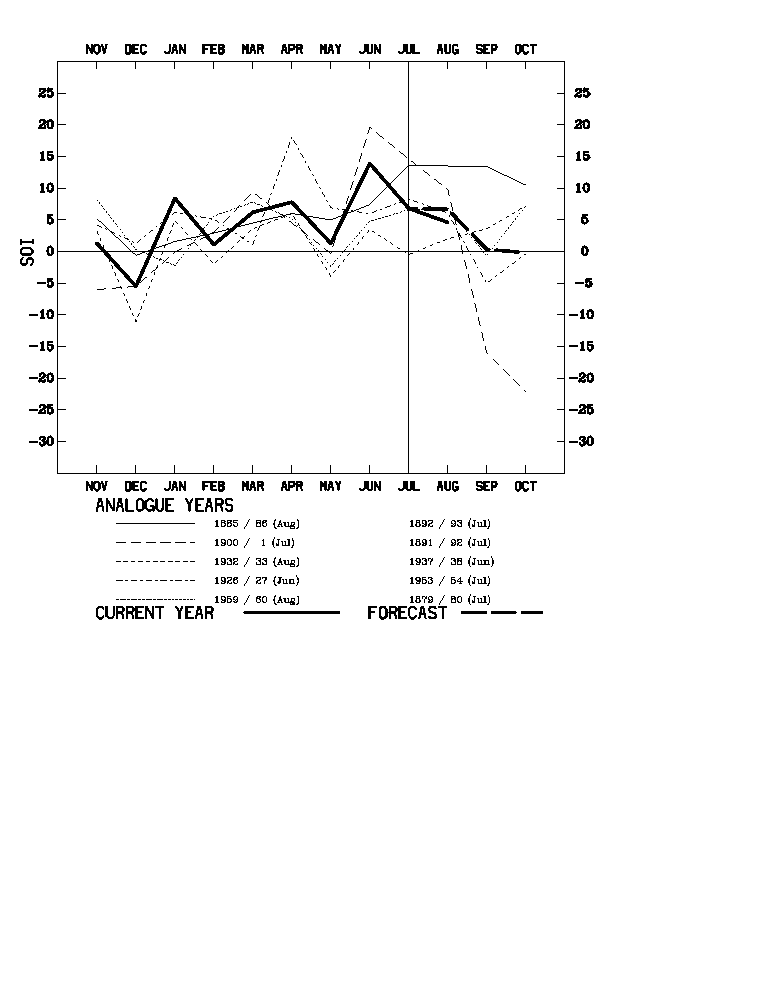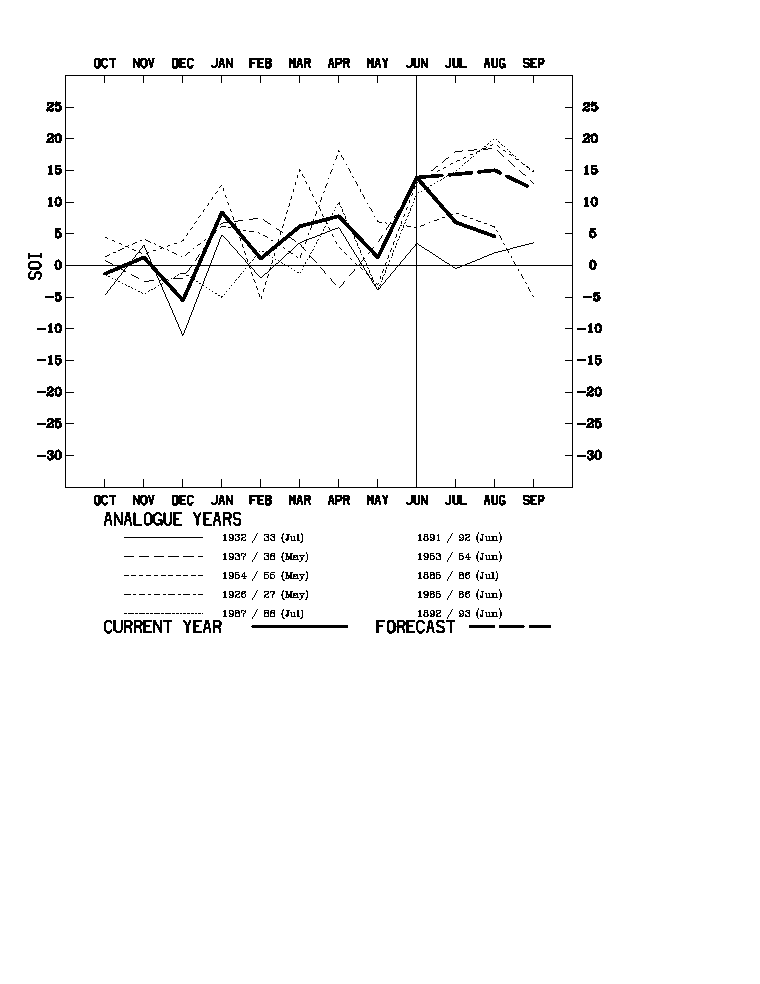
An analogue selection procedure, based on the non-linear
time series forecasting technique of Sugihara and May (1990), is applied
to the Southern Oscillation Index (Drosdowsky 1994).
The time series to be forecast xi is "embedded" in
an E dimensional space defined by a sequence of lagged coordinates (xt,
xt-g, x t-2g,..., x t-(e-1)g), where g
is the lag interval, usually taken as one time step. The E+1 closest neighbors
(analogues) to the current state, defined by the vector xt,
x t-g, x t-2g,..., x t-(e-1)g, are found
and used to construct the smallest simplex containing the current state.
Future states of the system are found by projecting each analogue forward
nT, where n=1,2,..., time steps and taking a suitably weighted average
of the analogues. The optimal embedding dimension E is determined by a
trial and error proced-ure, using the library of patterns formed by the
first half of the time series to predict the evolution at each point of
the last half of the time series. This effectively deter-mines the window
over which the analogue is selected.
The forecast system has been tested on time series with known properties.
For the SOI, the optimal em-bedding dimension is found to be of order 9
to 12. The operational scheme has been used in the monthly Seasonal Climate
Outlook issued by the National Cli-mate Centre of the Australian Bureau
of Meteorolo-gy since mid-1991. Analogues are selected from the entire
available SOI time series from 1876 to the present time. An element of
persistence is included in the forecast by adjusting the weighted analogue
so that the t=0 value agrees with the current observed base value.
The skill of the analogue system has been examined in hindcast experiments
(Drosdowsky 1994), and is shown in Fig. 9-1 in the September 1994 issue
of this Bulletin. For RMSE the one time step forecasts are approximately
equal to persistence while the two or more time step forecasts are more
skillful than persistence within the appropriate range of embedding dimension.
The spread of the analogues during the forecast period can provide a measure
of the confidence level of the forecast.
Beginning with the forecast that appeared in the December 1994 issue, an
improved SOI data set has It covered the same Jan. 1876-present period
as before, but periods of missing data were filled. Information on the
data set can be obtained from Rob Allan (rja@dar. csiro.au). Beginning
with this issue (9/96), SOI values are recalculated using means and standard
deviations from 1933-92. (Information: G.Beard @bom.gov.au).
Figure 1 shows the analogue forecast starting from August 1996 and extending
through November 1996. The SOI has remained at moderate positive values
over the past three months. There is little spread of the analogues over
both the selection period (December to August), now that the "predictability
barrier" has been passed. The behavior of the analogues during the
forecast period (September to November) is also fairly consistent, maintaining
moderate positive SOI values, except for the first (best fitting) analogue,
1900/01, which shows a major negative swing over the next three months.
The weighted analogue forecast therefore shows near zero SOI values from
September to November. However, discounting the anomalous first analogue
(1900/01) would result in the continuation of moderate (one-half SD) value
of the SOI. Forecast values for the next three months (in SD units X 10)
are:
| September 1996 |
-1.0 |
| October 1996 |
-1.2 |
| November 1996 |
0.1 |
Verification of the previous 3 months' forecasts:
|
F |
V |
|
| June 1996 |
2.6 |
13.9 |
| July 1996 |
6.6 |
6.8 |
|
August 1996 |
6.5 |
4.6 |
The forecast issued in early June performed quite well, maintaining
the positive SOI throughout the Jun-August period, apart from the magnitude
under-estimation of the June index.
Figure 2 shows the analogue forecast starting from July 1996 (one month
earlier than for Fig. 1), and Fig. 3 starting from June 1996. Some of the
same years are seen to have been selected for all three starting months.
The forecasts have been trending toward a less positive SOI over the three
start times, partly because some of the analogues indicating a continuation
of high SOI values are no longer being selected.
References
Drosdowsky, W., 1994: Analogue (non-linear) forecasts of the Southern Oscillation Index time series. Wea. Forecasting, 9, 78-84.
Sugihara, G. and R.M. May, 1990: Nonlinear forecasting as a way of
distinguishing chaos from mea-surement error in time series. Nature,
344, 734-741.
Figures

Fig. 1. Selected analogues and forecasts based on the SOI up to August
1996. Points corresponding to the July, August or September initial condition
have been used for selecting possible analogues. For clarity, only the
best five analogues are plotted (light dashed or dotted lines), labeled
with the year and month corresponding to the current month. (The remaining
five analogues are listed to the right.) Heavy solid and dashed curves
show the current and forecast values.

Fig. 2. As in Fig. 1, except based on the SOI up to July 1996. The verifying
value for August is indicated.

Fig. 3. As in Fig. 1, except based on the SOI up to June 1996. The verifying
values for July and August are indicated.